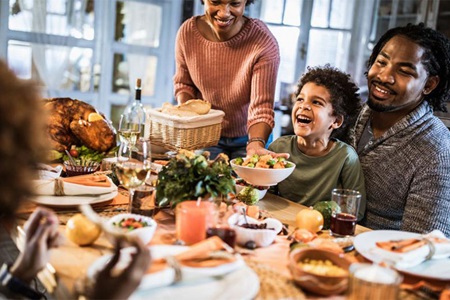Personalizing Your Plate for Your Culture
Eating Healthy Cultural Foods
Food nourishes our body, provides us nutrition and helps in managing diseases. Food also gives us comfort, brings back memories, and binds one another.
How we eat and what we eat reflect our culture. These are habits and preferences tied to our values, beliefs, and identities. These cultural practices can be incorporated into our daily meals. The dishes we eat can also bring us warmth and good feelings. Continuing to find pleasure in our food is an integral part of a healthy meal plan.
Here Are a Few Ways You Can Bring Your Favorite Cultural Food to the Table While Managing Your Diabetes:
- Follow the healthy eating principle
You probably have seen the healthy plate – half of the plate filled with non-starchy vegetables, a quarter of it with carbohydrates sources, and the remaining quarter with protein foods. It is a visual guide to remind you to have different food groups. If your culture does not use a plate to eat, try using your hand to guide you – have about two fists of non-starchy vegetables, one fist of carbohydrate food, and about a palm size of protein choice.
- Choose carbohydrates that are high in fiber
In addition to the widely available whole wheat or brown rice products in the market, you can also try including fiber-rich carbohydrate ingredients that are familiar to your culture. These include starchy vegetables (cassava, yuca, taro, yam, pumpkin, sweet potatoes), legumes (lentils, pinto beans, black beans), and grains (corn, amaranth, barley).
- Try a variety of protein sources
Chicken is the most preferred protein in the United States, but you can incorporate the protein food that you have enjoyed in your culture. These may include different types of fish, plant-based sources (e.g., legumes, nuts, seeds, tofu, tempeh), different types of animal protein (e.g., mutton, quail, duck), and dairy-based protein (e.g., cheese, yogurt). Choose a plant-based protein, fish, or meat of leaner options more often.
- Reduce, replace, rebalance
It is recommended to decrease the consumption of processed grain products and added sugar. You can do so by replacing some of the processed grain products with whole-grain food. For example, replacing white rice with brown rice. If this is not your preference or a specific food product or ingredient(s) are crucial for your cultural dishes, you may consider reducing the frequency or the amount of these ingredients. You may also try by rebalancing your plate, such as adding more non-starchy vegetables.
Talk to one of our registered dietitians if you would like to discuss more how you can personalize your plate, your meals for your culture.
Recipes
Servings: 4
Ingredients:
- 2 tablespoons oyster sauce
- 1 tablespoon low sodium soy sauce
- 1 tablespoon canola oil
- 1 large egg, lightly beaten
- 3 cups cooked brown rice
- 2/3 cup frozen peas and carrots, defrosted
- ¼ pound shrimp, precooked
- 2 tablespoons scallions, minced
Instructions:
1. In a small bowl, mix the oyster sauce and soy sauce together. Set aside.
2. In a large frying pan or wok over high heat, heat the oil. Add the egg, and scramble with a spatula or wooden spoon.
3. Lower the heat to medium and add the rice, peas and carrots, stirring to break up any grains of rice that stick together.
4. After a few minutes, when the rice and vegetables are hot, add the shrimp, and then drizzle in the oyster-soy sauce mixture.
5. Add the scallions, stir to distribute the ingredients. Serve immediately.
Servings: 6
Ingredients:
- 1 cup uncooked quinoa (2+ cups cooked)
- 2 cups water
- 3-4 cloves garlic
- 1 bunch cilantro
- 1 cup plain low-fat Greek yogurt (or regular low-fat yogurt, plain)
- 1 Tbsp extra virgin olive oil
- 1 tsp chipotle chili pepper
- 1 tsp cumin
- 1 tsp crushed red pepper
- Sea salt, fresh cracked pepper, to taste
- 1 cup corn
- 1 cup grated carrots
- 1 can reduced-sodium black beans, rinsed and drained
- Served over greens (lettuce, spinach, kale or any other leafy green).
Instructions:
1. Prepare quinoa according to package directions.
2. While quinoa is cooking, make the creamy cilantro dressing:
- Add cilantro and process until finely chopped. Scrape down the sides of the bowl.
- Add yogurt and turn the food processor back on. Stream in olive oil. Scrape down the sides of the bowl.
- Add cumin, crushed red pepper, salt, and pepper, and pulse a few more times to incorporate. Set dressing aside.
- Place garlic cloves in a food processor and process until very finely chopped. Scrape down the sides of the bowl.
3. When the quinoa is just a few minutes from being done, add the carrots and corn to the pot, cover and steam the veggies until tender-crisp.
4. In a large mixing bowl, combine the cooked quinoa, corn, carrots, rinsed black beans, and creamy cilantro dressing.
5. Serve warm, room temperature or chilled, as desired over.
Although this content is reviewed by Joslin Diabetes Center healthcare professionals, it is not intended to replace the medical advice of your doctor or healthcare provider. Please consult your healthcare provider for advice about a specific medical condition.




